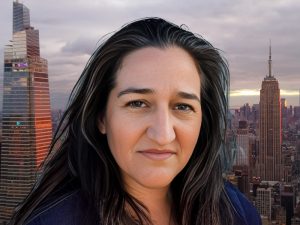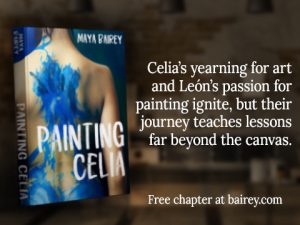SETTING RESEARCH: WHEN YOU DIDN’T WRITE WHAT YOU KNOW
SETTING RESEARCH: WHEN YOU DIDN’T WRITE WHAT YOU KNOW
 A woman floats peacefully in a swimming pool at night, a spangled view of the city behind her.
A woman floats peacefully in a swimming pool at night, a spangled view of the city behind her.
The image wouldn’t leave my head, and over time turned into a central scene in my debut romance novel, PAINTING CELIA.
Naturally, my character needed a house with a pool and a view. We don’t have those where I live in the Pacific Northwest, so I decided she would live in Los Angeles.
After my first draft, I realized I was making up an awful lot about LA. My armchair research in Google Street View might not be enough.A recent promotion had left me feeling rich. What if I went to LA and just looked around? Got a feel for places like the ones in my book? That’s what real authors do, right? What does one do on a research trip, though? How does one define “local color” and where do you get it?
I decided to “visit my characters” as though they were friends who would entertain me in their homes, show me where they worked, and tell me how the pressures and benefits of living in LA had shaped them.
I meticulously planned an itinerary, researching businesses and neighborhoods that were similar to those in my novel. One character—she of the swimming pool—lived up in the Hollywood Hills, another in Koreatown, and one ran a business in Boyle Heights.
Giddy, I booked a weekend flight, a hotel, and a far-too-expensive car. I nearly expected my characters to pick me up at the airport, so immersed was I in the idea that I was flying to their home.
And suddenly I was there, driving along a straight boulevard underneath palm trees. I used a hands-free voice recorder to save notes about the way the sun hit terra cotta apartment buildings, the vivid murals that flowed around windows to third floor balconies, and how the dust collecting on my dashboard was golden.
I didn’t even hit up my hotel first. Instead, I drove straight to a community art gallery I’d found which seemed similar to one in my book. Parking was as hard as I’d heard, but I found a space and hoped I’d find my way back after. I walked in, wearing a long-sleeved sweater that had been appropriate for my flight but now marked me as a sweaty outsider. I asked the woman at the front desk if I could ask questions about their operations, for my novel.
Within minutes, I was speaking to three bemused but flattered employees, all incredulous that anyone would write fiction about what they do. I walked out with far more detail than I could use and a glow I can still feel today. I did the same at two other businesses that weekend, receiving each time the same generosity.
Knowing how much money my characters supposedly made, I’d looked up apartments and houses for sale and chosen the closest matches. On my second day, I drove to each place, getting a feel for the neighborhoods. Were the roads wide or narrow? Was there a local grocery store my character might frequent? How did the neighbors landscape, what did they drive, and where did they park?
The house tucked away in the Hollywood Hills, the one with the pool, was ridiculously difficult to locate, but the journey was more informative than the glimpse I got of the house. The road twisted around hairpin bends, the sunset never in my eyes as every foot of road was shielded high on both sides by houses or ornate gates. Where I might have gotten a view down the canyons, landscaping or even temporary fabric fencing had been installed. The view was being deliberately blocked, I realized. From me, personally! If I had found a viewpoint, I would have stopped to look, blocking the single lane road for residents. I didn’t see that pool, but I learned plenty about the ingenuity of the locals.
For true local color, I texted the curator of a neighborhood museum in Boyle Heights. Again I walked in, sheepishly admitted to writing a book, and asked if we could talk. We ended up walking around the vibrant neighborhood for five hours, eating street food as mariachi music spilled from a bar. I saw actual locations of struggle and gentrification, and received a thorough retelling of the Zoot Suit Riots. What a gift.
 I had no interest in the Hollywood sign or a Santa Monica beach. Instead, I sat on a bench outside a clothing store I thought one of my characters might work at, and I ate lunch. What would they look at if they did the same? How did it shape them? How did they feel? If this was their lived experience, how did that become part of their thoughts and feelings? I know my characters, but sitting on a bench showed me detail after detail that told me why they made the decisions they do.
I had no interest in the Hollywood sign or a Santa Monica beach. Instead, I sat on a bench outside a clothing store I thought one of my characters might work at, and I ate lunch. What would they look at if they did the same? How did it shape them? How did they feel? If this was their lived experience, how did that become part of their thoughts and feelings? I know my characters, but sitting on a bench showed me detail after detail that told me why they made the decisions they do.
In my hotel that night, I heard booming sounds outside. What was this and how did it fit into my setting? A look out my window revealed fireworks. The Superbowl had apparently just ended, played a few miles away. The exorbitant cost of my rental car suddenly made more sense. I need not tell you that I’m not a big sports fan. The fireworks, I decided to leave out of the story.
On my flight home, I had a window seat and finally saw swimming pools. I was glad to see that even on steep canyon hillsides, people managed to engineer a pool into their backyard. Phew.
Could I write a novel with only armchair internet research? Yes. It turns out a lot of my impressions were surprisingly accurate. But having the resources to travel to the place and time my novel occurs was an immense privilege. I can’t wait to share the world I found, and how my characters love and hate in it, with my readers.
—
Maya Bairey is a Pacific Northwest author who has spent the past two decades as a corporate journalist. PAINTING CELIA, her first venture into publishing the personal, draws from her lived experiences with multicultural family and LGBTQ+ identity. In this lyrical romance, Maya explores love, healing, and the power of artistic expression.
Category: Contemporary Women Writers, How To and Tips






























